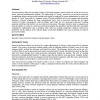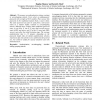AUSFORENSICS
2004
14 years 1 months ago
2004
Password policies alone do not stand a chance of securing computer systems which rely on the use of secretbased, password authentication methods. The enforcement of "strong&q...
GRAPHICSINTERFACE
2008
14 years 1 months ago
2008
Previous efforts involving picture-based passwords have not focused on maintaining a measurably high level of entropy. Since password systems usually allow user selection of passw...
CSREASAM
2008
14 years 1 months ago
2008
- We propose an authentication scheme resistant to eavesdropping attacks. Users select an alphanumeric password with a length of 9-15 symbols. They can use this password in the tra...
ARC
2006
Springer
14 years 4 months ago
2006
Springer
Abstract. This paper presents a hardware architecture for UNIX password cracking using Hellman's time-memory trade-off; it is the first hardware design for a key search machin...
SOUPS
2010
ACM
14 years 4 months ago
2010
ACM
Text-based passwords are still the most commonly used authentication mechanism in information systems. We took advantage of a unique opportunity presented by a significant change...
CSIE
2009
IEEE
14 years 4 months ago
2009
IEEE
Sometimes it is desirable to access password-protected resources, but undesirable to disclose the password to the machine in use. In such situations, providing the password is a t...
NDSS
1998
IEEE
14 years 4 months ago
1998
IEEE
This paper presents a new password authentication and key-exchange protocol suitable for authenticating users and exchanging keys over an untrusted network. The new protocol resis...
NDSS
1999
IEEE
14 years 4 months ago
1999
IEEE
Kerberos is a distributed authentication system that many organizations use to handle domain-wide password security. Although it has been known for quite some time that Kerberos i...
CCS
1999
ACM
14 years 4 months ago
1999
ACM
We present a novel approach to improving the security of passwords. In our approach, the legitimate user’s typing patterns (e.g., durations of keystrokes and latencies between ke...
CCS
2009
ACM
14 years 5 months ago
2009
ACM
The underlying issues relating to the usability and security of multiple passwords are largely unexplored. However, we know that people generally have difficulty remembering mult...




